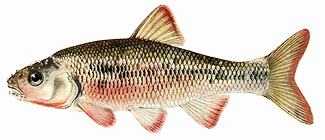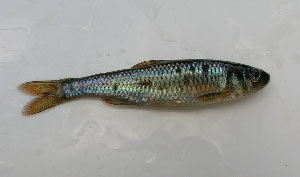Common Shiner
Notropis cornutus
 Distribution: The common shiner’s range includes the Great Lakes, upper Mississippi, and lower Missouri River drainages east to southern drainages of Hudson Bay, and south to Virginia. They are common and widespread throughout New Hampshire.
Distribution: The common shiner’s range includes the Great Lakes, upper Mississippi, and lower Missouri River drainages east to southern drainages of Hudson Bay, and south to Virginia. They are common and widespread throughout New Hampshire.
Description: Common shiners are a silvery minnow similar in appearance to the fallfish. Their scales are more laterally compressed, diamond shaped, and crowded toward the head. Scales slough off more easily than those of the fallfish, which are more rounded and plate-like. The fins of breeding males become reddish during spawning and their heads become covered with horny tubercles. For this reason, common shiners are sometimes referred to as redfin shiners.
Species commonly confused with: Fallfish, golden shiner, spottail shiner
Habitat: Common shiners are found in small streams to medium sized rivers with unvegetated, gravel to rubble bottoms. They tend to concentrate in pool habitat.
Life History: Common shiners are a short-lived species, rarely exceeding 8 inches (200 mm) in length. Spawning occurs in late spring and early summer, when female common shiners lay adhesive eggs in shallow depressions which the males excavate in sand or gravel. They have also been known to lay eggs in the nests of other fish species. At first glance, common shiner habitat appears suitable for brook trout, but a higher temperature tolerance and a more omnivorous diet allows common shiners to thrive in warmer streams. During periods of high turbidity, common shiners have been found to shift from feeding on small invertebrates to a diet of plant matter. Its tolerance of warm temperatures and its adaptable foraging strategy make the common shiner relatively tolerant of habitat disturbance.
Origin: Native

Conservation/Management: Common shiners are predominantly a riverine species in New Hampshire. Altered flow regimes in rivers may lead to a reduction in the populations of common shiners and other riverine species. Altered flow regimes may be the result of impervious surfaces, which direct runoff into rivers and streams. This leads to flashy flows during storms where water that once absorbed into the ground and percolated slowly into streams now runs quickly over the surface and causes rapid increases in flow. When stormwater absorbs into the ground, it recharges the ground water supply, which maintains higher base flows during the summer. Flashy streams have a greater tendency to dry up during periods of drought. As runoff increases in a watershed, rapid increases in flow begin to increase bank erosion and sediment deposition in local streams.
Altered flow regimes also occur in rivers with dams that artificially manipulate water levels. Sudden releases of water or stoppages in flow make it difficult for riverine fish species to complete their life cycles. Sudden changes in water level during spawning may wash away or expose recently deposited eggs. Healthy populations of riverine fish species, including common shiners, fallfish, blacknose dace, and longnose dace, can be used as an indicator for rivers and streams with natural flow regimes. Conversely, river systems where riverine fish species have been replaced by lacustrine species, such as largemouth bass, sunfish, and golden shiners, may be a sign of an altered flow regime. Understanding the distribution of fish communities is critical for establishing and enforcing regulations for protecting instream flow.



